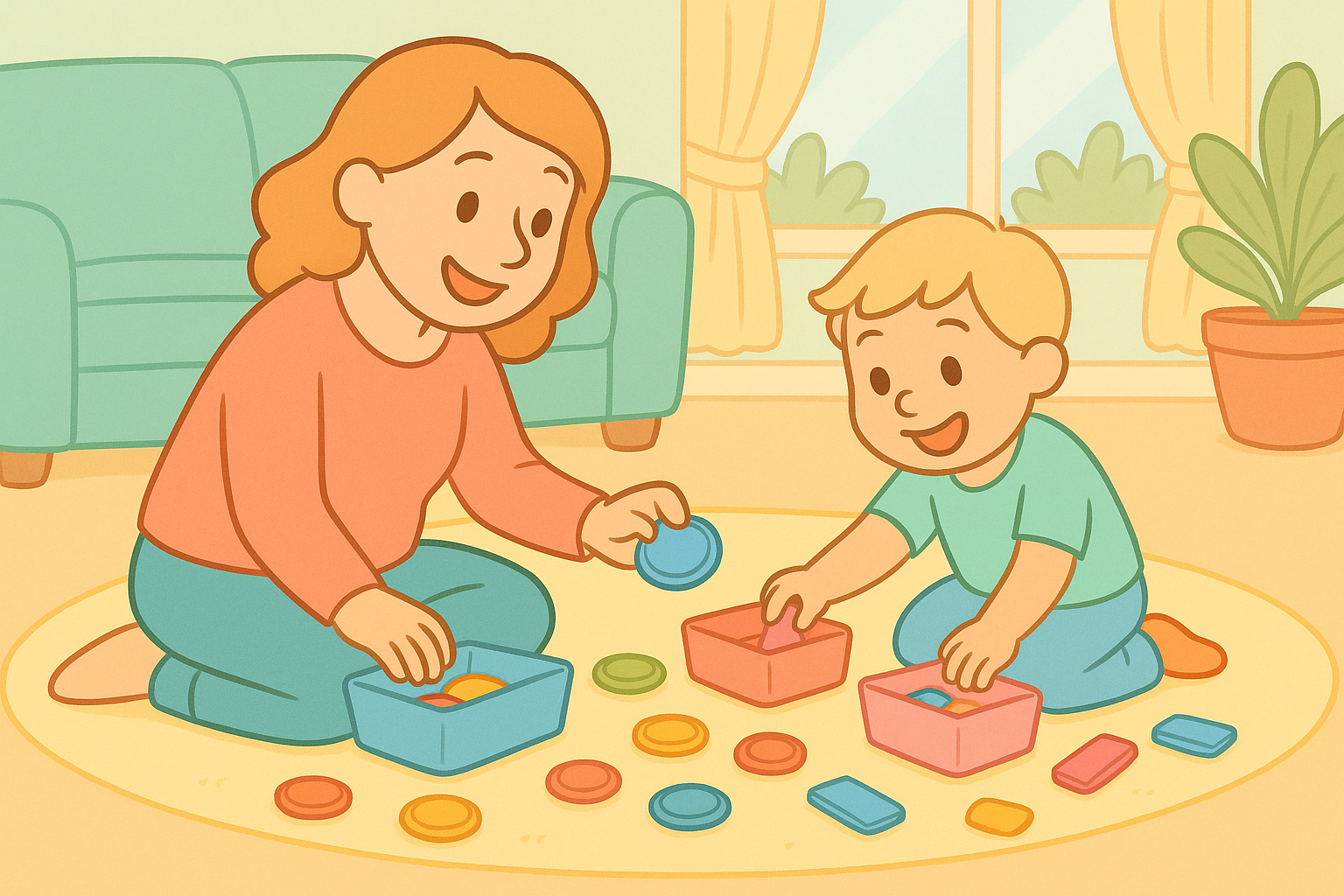Teaching Sorting and Categorizing with Household Items
Teaching Sorting and Categorizing with Household Items
Why Sorting Is a Foundation for Learning
Before kids can read, count, or solve problems, they must learn how to see relationships — noticing what’s the same, what’s different, and how things fit together.
That’s why sorting and categorizing are such powerful early learning skills. They teach children to observe, compare, and organize the world — skills they’ll later use for math, science, and even literacy.
The Science Behind Sorting
Sorting taps into several key areas of brain development:
Attention and focus: Learning to look closely at details.
Cognitive flexibility: Shifting between categories or criteria.
Language and vocabulary: Naming attributes like color, size, shape, or purpose.
Math readiness: Recognizing sets, patterns, and quantities.
When children group items by shared features, they’re building the same analytical thinking they’ll use later for addition, phonics, and scientific reasoning.
(Also see: The Science of Early Learning: How the Brain Builds Connections)
Step 1: Start with Observation
The first step is simply noticing differences. Invite your child to explore objects by asking open-ended questions:
“What do you notice about these?”
“How are they the same?”
“Which one looks different?”
Encouraging this kind of noticing builds attention and descriptive language — the foundation of categorizing.
Step 2: Introduce One Sorting Rule at a Time
When you first start, stick to a single rule — like color, size, or shape. This helps children stay focused without getting overwhelmed.
Try These Early Sorting Ideas:
Color sorting: Socks, blocks, or buttons.
Size sorting: Cups, spoons, or lids.
Shape sorting: Cookie cutters or toy pieces.
Texture sorting: Smooth vs. rough objects.
(Also see: Building Hand-Eye Coordination Through Play)
Once your child is comfortable, add a twist — mix categories or ask them to come up with their own rules.
“Can you sort by what’s soft and what’s hard?”
“What about things we use in the kitchen vs. the bathroom?”
Step 3: Use What You Already Have
The best learning tools are often right at home.
Here are some everyday materials perfect for sorting and categorizing:
Kitchen Items
Measuring cups (by size)
Pasta shapes or beans (by type)
Snack foods (by color or shape)
Laundry Room
Socks (by size or color)
Towels (by family member)
Clothespins (by color or material)
Toys and Playtime
Blocks (by shape, size, or color)
Cars (by wheels, brand, or use)
Stuffed animals (by type or size)
Nature Items
Leaves, rocks, or shells (by size, color, or texture)
Sticks and pinecones (by weight or shape)
(Also see: Exploring Nature to Teach Observation Skills)
Step 4: Make It Interactive and Playful
Turn sorting into a game rather than a task.
Fun Game Ideas:
Sorting Race: “Let’s see how fast we can put all the blue ones together!”
Mystery Bag: Reach in, describe what you feel, and guess its group.
Laundry Helper: Match socks or sort by who each item belongs to.
Snack Sort: Separate pretzels, raisins, and cereal — then enjoy!
When learning feels like play, attention and motivation skyrocket.
Step 5: Add Language to Strengthen Thinking
Encourage your child to talk about their choices while sorting.
Ask:
“Why did you put those together?”
“What makes this one belong here?”
Explaining reasoning out loud builds verbal reasoning and conceptual understanding — two major predictors of academic success.
(Also see: Teaching Emotional Recognition Through Storytime)
Step 6: Introduce Multi-Level Sorting
Once your child masters one category, introduce more complex tasks:
Sort by two attributes: “Group by color and size.”
Create new categories: “Let’s sort by what’s used for cooking vs. playing.”
Add problem-solving: “What if this one fits in two groups?”
This step encourages cognitive flexibility — the ability to shift between ideas — which supports creativity and higher-level thinking.
Step 7: Connect Sorting to Everyday Routines
Sorting is everywhere in daily life — and kids love to help when they feel included.
Try:
Putting groceries away by category.
Organizing art supplies by color.
Arranging shoes by size or type.
Sorting recyclables — paper, plastic, metal.
You’re not just teaching organization — you’re reinforcing classification, sequencing, and real-world math concepts.
(Also see: Encouraging Curiosity During Daily Routines)
Step 8: Bring Math Language Into the Conversation
Introduce gentle math words while sorting:
“More” and “less”
“Biggest” and “smallest”
“Same” and “different”
“First,” “next,” and “last”
You don’t need to quiz — just narrate naturally.
“We have more red lids than blue ones!”
This kind of math talk boosts early numeracy and logical reasoning.
Step 9: Use Visual Tools for Support
Create visual anchors to help your child see categories clearly:
Use baskets or trays with picture labels.
Draw or print icons (toothbrush for bathroom, spoon for kitchen).
Use color-coded bins or mats.
Visual cues strengthen memory and independence — especially for toddlers and preschoolers.
(Also see: Using Visual Schedules to Support Early Independence)
Step 10: Celebrate the Thinking, Not Just the Result
When your child sorts correctly, celebrate — but also praise the process.
“I love how carefully you looked at the shapes.”
“You changed your mind when you found something new — that’s great thinking!”
Focusing on the why builds flexible, curious learners who enjoy problem-solving, not just getting it “right.”
(Also see: How to Build Confidence in Early Learners)
Common Mistakes to Avoid
Overloading categories: Too many options can overwhelm.
Correcting too quickly: Let kids explain their reasoning before jumping in.
Skipping the talk: Conversation cements understanding.
Forgetting joy: Keep sessions lighthearted and brief.
(Also see: How to Support Kids Who Resist Structured Learning)
The Bigger Picture
Sorting teaches children to see patterns, relationships, and order — the backbone of math, science, and logic.
When you build sorting into everyday play, you’re nurturing a child who observes carefully, reasons deeply, and sees beauty in organization.
“Every time your child groups and compares, they’re not just learning — they’re thinking like a scientist.”
This content is for educational purposes and is not a substitute for professional medical or psychological advice.
Popular Parenting Articles




